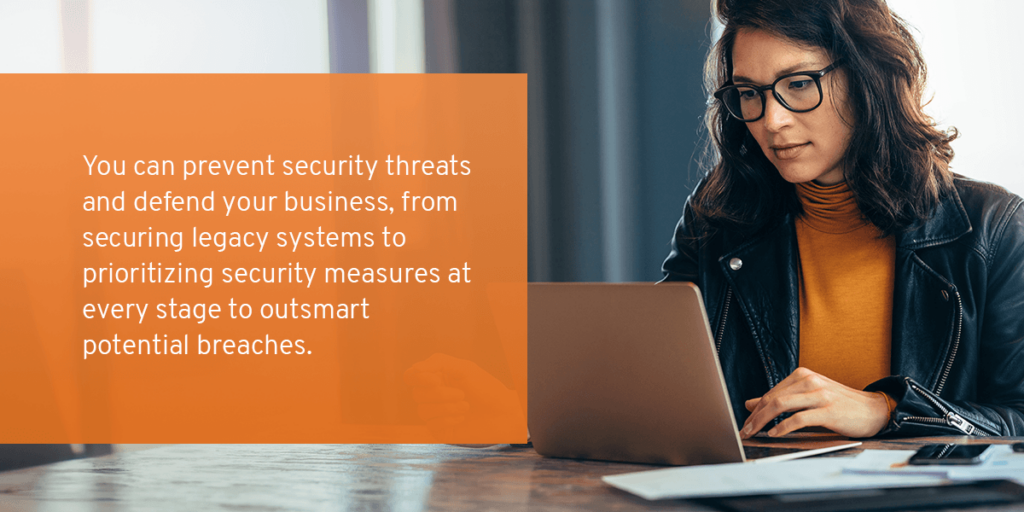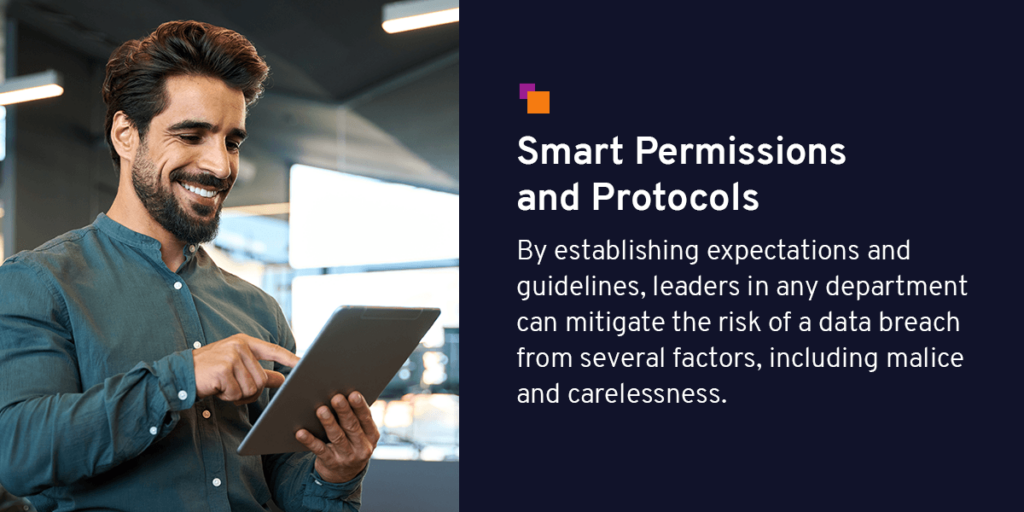In the first two installments of our “Danger for Data” series, we covered the risks of data breaches and where they live in an organization, focusing on both the IT side and the business side. It’s clear — the question isn’t whether a breach will occur but when. Our mission now is to equip you with the tools to safeguard your data fortress.
In this third installment, we’ll reveal various strategies, outlining how to prevent a data breach, shield your company from security threats and, in some cases, significantly improve efficiency in existing workflows and daily tasks. Discover bring your own device (BYOD) security best practices and why due diligence is critical to your security strategy.
How to Protect Your Company From Cyberattacks
You can prevent security threats and defend your business with various effective strategies, from securing legacy systems to prioritizing security measures at every stage to outsmart potential breaches. By adopting these approaches, you empower your defense against cyber perils, fortify your data fortress and ensure your business’s safety and success.

Employee Training and Awareness
Your employees are the first line of defense against cyber threats. It’s essential to equip them with the knowledge and awareness to identify and respond to potential risks. Employee training and awareness programs help cultivate a security-conscious workforce that recognizes phishing attempts, practices safe browsing habits and understands the importance of safeguarding sensitive data.
Regular training sessions and interactive simulations make your team a formidable barrier against data breaches. By nurturing a culture of vigilance and accountability, you foster an environment where every staff member actively contributes to protecting your company’s digital assets. Employee training and awareness prevent breaches and elevate your organization’s cybersecurity posture.
Fortifying Legacy Systems
Navigating the challenges of legacy systems doesn’t have to be a puzzle. While replacing them entirely might seem overwhelming, there are effective ways to safeguard your aging infrastructure. These systems, often resistant to change, require tailored approaches for security. The first thing to do is patch the legacy system to bring it up-to-date and fix known vulnerabilities.
Consider secure data exchange platforms to integrate legacy systems seamlessly into modern workflows or quarantine them to minimize network exposure. While this is certainly not an exhaustive list of your options, it does provide an excellent place to start so you can begin formulating your strategy to safely extend the value of these systems.
Smart Permissions and Protocols
Permissions and protocols are critical throughout an enterprise on both the IT and business sides. By establishing expectations and guidelines, leaders in any department can mitigate the risk of a data breach from several factors, including malice and carelessness.

Consider your development team’s data permissions — a pivotal aspect that’s often underestimated. While granting broad access may seem expedient, this leniency can backfire. All it takes is just one employee making a mistake or one intelligent thief sneaking in. Opt for a “need-to-know” approach, assigning permissions only to those essential to specific folders. Regularly audit and update permissions, ensuring restricted access remains a constant practice. Additionally, organize your data so the folders match people’s roles, ensuring only the necessary data is exposed to them.
What’s outlined above is very similar to a strategy called “zero trust.” At its core, zero trust is an internal-facing security strategy focused on hypervigilance around systems, information access and who is on your systems. A good example is White House security — someone might be a vetted, trusted entity, but that doesn’t mean they should have full access to your networks or systems.
Similarly, in a BYOD setup, strict expectations and security measures must be woven into a comprehensive policy. Determine eligibility, acceptable devices — such as laptops, desktops, smartphones and tablets — data access rights and ownership protocols to create an airtight defense. Still, it’s important to note that applying BYOD policies have pros and cons. This policy may reduce business costs and increase employee efficiency. However, it can also make your enterprise vulnerable to a data breach if you do not put forth expectations and appropriate security measures as part of a comprehensive policy.
Here are a few things to consider when embarking upon a BYOD program:
- Who is eligible to participate?
- What are the recovery procedures if the device is lost/stolen?
- What are acceptable devices and operating systems?
- Who has access to what company data?
- What is the ownership of information on each device?
- What constitutes appropriate use?
- Adopting a zero-trust strategy.
Thorough Due Diligence
In cybersecurity, taking the time for meticulous due diligence is a non-negotiable step toward safeguarding your company’s digital landscape. Whether you’re integrating an API into your solution or evaluating potential vendors, each decision carries weight in fortifying your defense against data breaches.
Suppose you’re considering using an API as part of your organization’s solution. In that case, you’ve likely already done some research to determine the type of API you need, potential vendors and whether or not they have ample documentation. You may have even looked into the security of the APIs you’re considering using — and if you haven’t, you should.
As I mentioned in part one of this series, choosing an API with SSO authentication, strong encryption and rate limits are a few good factors to look for that will reduce your risk of a breach. However, it’s equally vital to scrutinize the level of support you’ll receive. Probe into the specifics and ask questions like:
- What kind of support will they provide?
- Who is responsible for updates and bug fixes?
- Can you try a free version of the API to see how it works with your existing systems before committing?
Exploring these dimensions ensures a well-rounded understanding before you commit.
Protect Your Data in Motion
When evaluating the security of your organization’s data exchange solutions, internal and external threats pose challenges that demand a united front from your IT and business teams. In an era of heightened security stakes and evolving compliance demands, aligning your organization’s goals with IT-driven secure exchange solutions becomes imperative.
Here are a few examples of why the business should work with IT for better secure exchange solutions:
- The ghost in the fax machine: Traditional fax machines may seem innocuous, but they harbor a lingering risk. Confidential client data and critical account information can be easily accessed from their memory, posing a perpetual threat. And the “private” data you send often sits in plain view in the middle of the recipient’s office.
- “Confidential” is a canard: Consider this — you send an email or receive an automated message after a client updates their account. It might have had a bold “Confidential” in the subject and a promise of confidentiality in the signature. But these so-called “security measures” are akin to those “Do Not Remove Under Penalty of Law” tags on new pillows — ineffective. Unless you sent that information via an encrypted, secure exchange method, your message is anything but secure or compliant. Encryption can make your information truly confidential and therefore useless to a potential thief, who would have been better off stealing pillows.
- Stumbling around security: A clunky interface or the requirement of more than a couple of steps to exchange information securely is a surefire way for your security system to hinder productivity and for people to bypass it to get work done. This causes well-meaning employees to lead the business into a nasty data breach.
There are simple, secure exchange options that won’t burden your development team or blow your budget — with some even designed to accelerate your business. For example, to provide a seamless, productive and secure experience for your customers, clients and employees, consider adding secure exchange into the systems they already use. With modern REST APIs and secure protocols, your development team can quickly embed message center functionality to allow easy, secure digital exchanges between your customer-facing apps and internal customer service systems.
For a turnkey option, consider implementing a pre-built secure mailbox. With a secure email content filter, you’ll have a secure system that scans every email and attachment your organization sends for sensitive information. The filter will automatically encrypt messages when necessary — thus, protecting your enterprise against human errors.
Or going back to those legacy systems that send out automated emails and documents containing sensitive customer information — remember to protect those exchanges with integrated secure message delivery functionality. The best part about all of these options? None involve rip-and-replace or require building a secure exchange solution from scratch. Simply evaluate your current solutions and processes, determine what kind of solution is best for your organization and then adopt your chosen solution where necessary.
Prioritize Security From the Start
Simply put, when your organization deals with sensitive customer, client or patient information, security should always be top of mind. In fact, in recent years, there’s been a push for developers to “shift left” and move security testing earlier in software development cycles.
According to Google, this concept’s rationale is that a security flaw typically results from several interacting factors rather than a single error. By moving security testing to the beginning and throughout the development cycle, developers can detect faults earlier and fix them in smaller batches rather than en masse at the end of the process. In short, operating with a “security-first” mindset results in secure systems and better efficiency.
This mindset extends to your enterprise’s business side, encompassing staff security training and multifactor authentication (MFA). MFA, which includes robust passwords and additional authentication steps, is the primary defense for safeguarding critical data stored in employee emails, messaging systems and other accounts.
Training your staff on creating a password is a big step toward improved security. Staff should create strong passwords that mix numbers, symbols and upper and lower-case letters — ideally avoiding commonly-known cues such as a birthday or a pet’s name. Here are a few tips on creating — and remembering — strong passwords.
Regular Security Audits
Regular security audits are like giving your company’s data a protective shield. These audits involve systematic reviews of your systems, processes and protocols to identify vulnerabilities and potential weak points. By doing so, you can proactively detect and address security gaps before they become entry points for cyber attacks.
Think of security audits as your digital insurance policy. They ensure that your organization’s defenses remain up-to-date and effective against evolving threats. Regular checks provide valuable insights, helping you stay ahead in cybersecurity.
Safeguarding Your Data With DataMotion
In the dynamic landscape of data security, knowing how to prevent security threats is a necessity. Throughout this series, we’ve unveiled actionable remedies to fortify your defenses and navigate the complex realm of cyber threats.
Take control and champion a security-first approach with DataMotion’s secure exchange solutions. We reduce complexity and costs, providing you with a secure communication experience tailored to your needs. Our mission is to empower your business and ensure we handle your data with the utmost care.
Safeguarding sensitive information is no longer a daunting task — it’s an opportunity to enhance your organization’s efficiency and customer satisfaction.
Be sure to read the other parts of this series:




